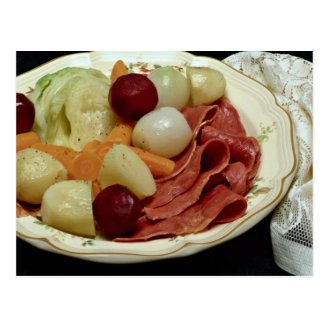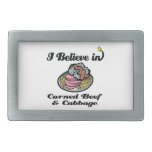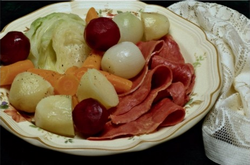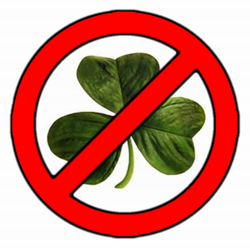For centuries, the Catholic Irish had marked St Patrick's Day with a special meal at home.
A firm favorite was unsliced back bacon, boiled and served with cabbage and potatoes. If available, other vegetables were chucked into the mix. The whole dish would be presented with a sauce.
Often this would merely be the boiling juices trickled over the top. But if they were feeling particularly flush, the Irish family would pour over some white sauce (a mixture of flour, butter, milk and parsley, though another herb can be substituted).
Bacon and cabbage was thus the closest thing that Ireland got to a traditional special meal for St Patrick's Day. But they weren't adverse to eating it any other time too.
Naturally, given the circumstances from which they'd fled, and now found themselves, this dish was a distant memory. It was certainly not anything that a resident of the Five Points could afford to cook.
So they got creative. There was no bacon in their price range, so they took inspiration from their Jewish neighbors. The Jews had a salt beef, cured or pickled in brine, the preparation for which they'd brought with them from Eastern Europe.
Generally cut from older cattle, hence being quite tough, it sold for a lot less than other kinds of meat. The Irish could afford it! At least once in a while. So that was their bacon substitute. This briny beef brisket is what's today known as corned beef in America.
Guess what was the cheapest vegetable you could buy in the New York slum area?
Voila! Corned beef and cabbages was invented! Not over in the Emerald Isle, but in the middle of lower Manhattan. The people who conceived of it, and popularized the dish, had indeed been born in Ireland. However, they were now Irish-Americans.
Their St Patrick's Day religious observances called for the the best meal they could produce on March 17th. Right then and there, that was corned beef and cabbage. Hence the association stuck and it's still a thing in the USA today.
















 St Tydecho's Churches in West Waleson 09/03/2014
St Tydecho's Churches in West Waleson 09/03/2014
 Goodies for an Outlander Premiere Partyon 03/06/2015
Goodies for an Outlander Premiere Partyon 03/06/2015
 Holocaust Memorial Day Interview with Rainer Höss, Grandson of Rudolf Architect of Auschwitzon 01/24/2015
Holocaust Memorial Day Interview with Rainer Höss, Grandson of Rudolf Architect of Auschwitzon 01/24/2015
 Romantic Valentine Gifts for an Outlander Fanon 01/16/2015
Romantic Valentine Gifts for an Outlander Fanon 01/16/2015



Comments
Opportune was the conclusion I came up with too, when I was studying this at Uni. Half the time it was out of sight out of mind too. I guess it's why those sort of people get on.
I can understand how some people can watch others starving for profit: greed and hatred. They despised the Irish, wanted them dead and saw famine as a useful way of effecting this. Genocide was not planned, but was opportune, taken up willingly by a section of the British ruling class. Greed for profit was the only goal of some. It dominates their minds and hearts at the expense of all else.
It's freaking tragic how much food came out of Ireland in the 19th century. I don't understand how anyone could watch a people starving for profit.
Frank - I never thought to wonder about the soil. I bet this accounts for regional differences in food consumption too, at least back in the day before supermarkets.
Madelyn - You're very welcome. It was a Californian with whom I was chatting about it! So perhaps you're missing out there, or she's adding random stuff.
I have just done some research. Irish corned beef was a major export in the nineteenth century, though for most Irish it was a luxury hardly obtainable. The export of corned beef added to the effects of the potato famine.
You are right that this meal is in no sense traditional. It is, as you say, a descendant of a characteristically Irish dish, bacon, cabbage and potatoes. I suppose that the emigrants ate some characteristically Irish food to remember home.
There is a perfect rationale to this dish. The Irish grew potatoes and they kept pigs. Cabbages grow easily in the Irish climate. As Ireland lies on a bed of limestone, there are some limy soils, which cabbages like to grow in. The beetroot that you show as added to the dish is a very versatile vegetable that grows in a variety of conditions [it is a descendant of the genetically varied sea beet and grows easily.] So the poorer soils of the West of Ireland could be guaranteed to grow this vegetable.
The poorer people of Britain and Ireland were not great beef eaters [until corned beef came in.] This is despite the rubbish talked about the roast beef of old England.The poor, of whom there were many in Ireland, could only afford corned beef, which was a luxury substitute for bacon.
I've never ever heard of this dish before, lolwut?!?! Maybe it's just not a West Coast thing...I'm a California girl. We celebrate St. Patties with tacos and beer...but then again, I only know Irish-Mexicans so *cough* This has been a highly entertaining read. Thanks for sharing!
I always appreciate your humour. :)
I love trying out food from all over the world, and from many different cultures. If it's vegetarian and looks, smells and tastes delicious, then I'm right there with my fork. So what would you cook for this 'white girl'? *waits with cutlery*
I'm glad to hear that my article brought back such good memories!
JoHarrington – Glad you appreciate my humor.
It goes deeper than you know. Allow me to share.
My mom once told me my grandfather, her father, was Irish or from Ireland, or had some of Irish roots. She never really clarified. We used to tease my aunt, my mother's sister, about always cooking “white people food”. But the best dish she ever made was corned beef and cabbage. To top that off she worked at a dress shop located in Miami Beach, Florida. Miami Beach was loaded with rich retired Jews. So how my aunt learn how to prepare corned beef and cabbage? We don't know!! But it was a dish none of us would ever turn down!!
I never met my grandfather. He died before I was born. My mother and aunt passed away many years ago. So as I was reading your article, memories that had been buried in my subconscious started resurfacing. They were so sweet but I started cracking up!!! :)